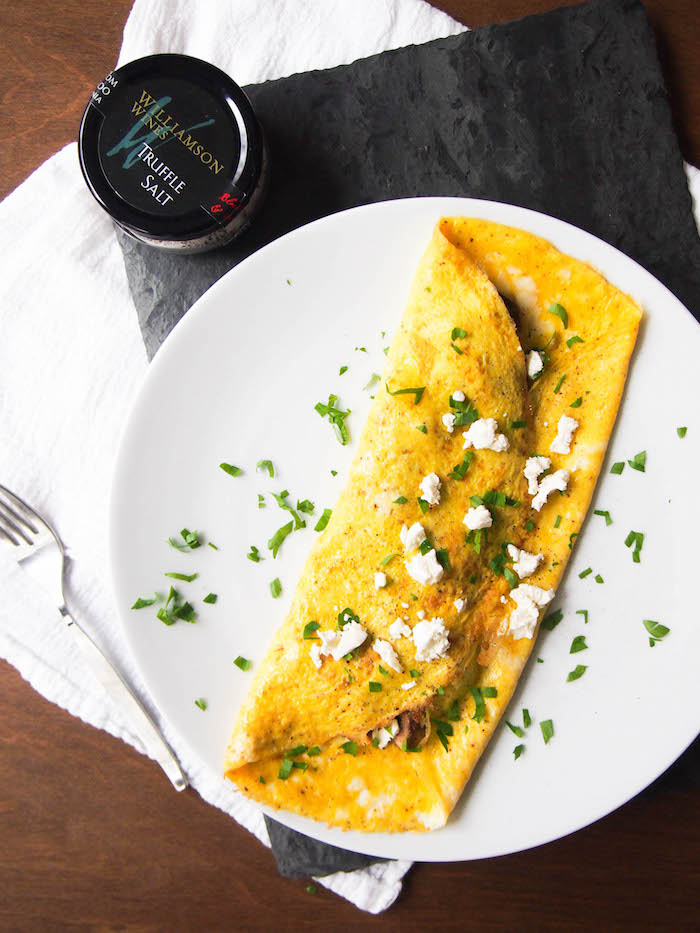How to Make the Perfect Omelette + Recipe for Simple Mushroom and Goat Cheese Omelette
Learn my tricks for how to make the perfect omelette with a creamy, custardy texture, plus a simple recipe for mushroom omelette with goat cheese.
Earlier this week, I read a really interesting article, "The Myth of 'Easy' Cooking." It got me thinking differently about the recipes I share and how I approach cooking. I encourage you to give it a read, especially if you feel like you're constantly strapped for time, running around like a crazy hot mess (i.e. me most of the time). If you're too busy to read it right now, running around like a crazy hot mess, basically, the summary is this:
Easy recipes aren't actually easy.
With the recent emphasis on clean eating, home cooking has become the gold standard of healthy eating. As someone who firmly believes in the power of whole food, I can certainly agree with that designation. In my practice, I spend a considerable amount of time with my clients teaching them how to make home cooking a realistic and regular habit.
But, we can't forget that it comes at a cost and that cost is time. Time is a precious commodity, especially for anyone with children, working a job more than 40 hours a week (hi!), multiple jobs, a long commute, or is active in their community.
With the barrage recipes marketed as easy, which I am absolutely guilty of too, it's easy (pun intended) to feel guilty for not having time to cook. Why can't I find the time to make homemade almond milk in three different flavors for the week?? The recipe says it only takes 15 minutes! And I know I'm not the only one who has taken well over an hour to cook a Rachael Ray 30 minute meal. With 19 ingredients, it takes me 30 minutes just to hunt down the ingredients in my kitchen!
The problem isn't you, it's the recipes. Not that the recipes aren't actually semi-easy or relatively quick if you've done them before. It's the fact that we're using recipes in the first place. As the author states, "real 'easy' cooking, if that’s what you’re after, is far too simple to sustain a magazine and cookbook industry. It relies on foods that can be purchased at a single point of sale and involves a bare minimum of ingredients and a small repertoire of techniques. It leans heavily on things your mom taught you."
Basically, it's not about knowing how to follow a recipe, it's about knowing how to cook. Sure, recipes are helpful for teaching people how to cook (and of course baking, which is much more scientific). But once you know how to cook, you can skim a recipe for inspiration without spending time reading it word for word. When you know how to cook, know what ingredients are extraneous and can be left out. When you know how to cook, you know what a teaspoon or a third of a cup look like, so you don't have to spend time measuring.
Inspired by that article, I plan to share more posts discussing basic cooking techniques rather than specific recipes. 'Non-recipes' that give you the basic instructions you need to create a gourmet tasting meal without spending a lot of time in the kitchen.
Alas, I give you a 'non-recipe' for omelettes. They've sustained me many a day! Whether it's for breakfast paired with fresh fruit or dinner with a side of toast and greens dressed with lemon juice and olive oil, omelettes are super simple yet feel gourmet when made with seasonal ingredients and good technique.
So, you probably know how to make an omelet, but do you know how to make a perfect omelet? Well, I probably don't either. Who are we kidding? I'm no chef! But...I do know how to make a damn good omelet, and I think that's good enough. Here are my tricks of the trade:
Precook vegetables. With the exception of spinach, which wilts in approximately 2.5 seconds, there's nothing grosser than raw vegetables in an omelet. I often use omelettes as a way to use up leftover vegetables, or I'll batch cook vegetables on the weekend. Then there's the ultimate time saver - frozen, defrosted vegetables. #nojudgement
Use a nonstick skillet. Save yourself the hassle. Just do it.
If you can, use room temperature eggs. This is by no means a rule, because goodness knows I regularly forget to take my eggs out of the fridge in advance. But if you can, it helps give the eggs a custardy texture. Sometimes I'll put them in room temperature water to raise the temperature a bit.
Beat the eggs with a fork until completely mixed and season with a little salt and pepper. Add dried or fresh herbs if you like.
Heat the dry skillet on medium-high heat a minute or so before adding butter. This makes sure it's nice and hot, which will help the omelette cook quickly. On the topic, while I don't use a ton of butter, I am pro-butter vs olive oil when omelette making. It tastes so much better. The pan is ready when the foam in the butter subsides.
Pour the beaten eggs into the hot pan then tilt so it covers the skillet. After it's in the pan, DON'T TOUCH THE EGGS! You want it to get a nice crust so it's important to let it sit.
When the eggs are mostly set, but still a little wet in the middle, add the filling. The eggs will finish cooking with residual heat. If you cook it fully, your omelette will be dry.
Immediately fold one side over the fillings using a wide spatula (I like this one). As you tilt the pan on to your plate, filled side first, flip the other side over the fillings so you've got a trifold.
Cheese. This deserves a special note of it's own. Crumbly cheese like goat or feta should go one top, while shredded hard cheeses that melt and get gooey should go inside. This is not personal preference, but rather a cold, hard, scientific fact.
Now, let's talk fillings. I'd love to hear your favorites in the comments below! Here are some of mine:
smoked salmon + goat cheese + tomatoes + avocado
red onion + corn + tomatoes + sharp cheddar
asparagus + brie
spinach + sun dried tomato + pesto
kale + olives + feta + oregano
chilies + black beans + tomatoes
And of course, garlicky sauteed mushrooms...
Simple Mushroom and Goat Cheese Omelette
Makes 2
Ingredients
Extra virgin olive oil
Shallot, finely chopped
Garlic, minced
Mushrooms, cleaned and chopped
3 large eggs, preferably at room temperature
Butter
Goat cheese
To garnish (optional): truffle salt, chopped parsley
Instructions
Heat olive oil in a skillet on medium-high heat. Add shallot and garlic and saute 1 minute until fragrant. Add mushrooms and a pinch of salt and pepper. Saute until liquid is released and absorbed, about 10 minutes. Remove from skillet, set aside and wipe skillet clean if making omelette immediately. Or refrigerate until needed, then reheat briefly in the microwave.
Crack eggs into a bowl and beat until completely mixed with a fork. Season with salt and pepper.
Place clean skillet on medium-high heat. Add knob of butter, dragging it over the pan with the tip of your knife as it melts to cover the skillet. When foam subsides, pour in the egg, lifting the skillet to spread it evenly. Cook until eggs are mostly set, but still appear wet on top.
Add mushrooms in a line down the middle. Immediately flip edge of eggs over the fillings. Press down slightly to 'seal'. Slide filled side of omelette out of the skillet and on to the plate while flipping the other side over the top to make a tri-fold.
Crumble goat cheese over the top, garnish with truffle salt and parsley and serve.


